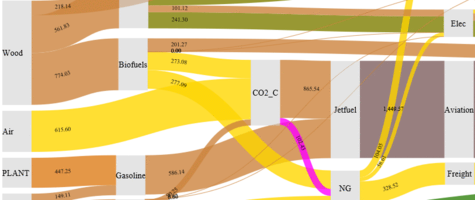Research project
Energy and carbon flows
Today, Switzerland covers around three quarters of its energy needs through imports. The upcoming energy transition is leading to uncertainty about future energy supplies and a desire to make greater use of domestic energy sources. However, renewable resources such as biomass are only available to a limited extent. Against this background, the project "Carbon Flows in the Energy Transition" was launched at the Institute for Energy Technology IET. Together with EPFL in Sion, the IET investigated the various energy and carbon sources in Switzerland. Among other things, the research project shows that CO2 levies of between 400 and 700 francs per tonne of CO2 are necessary to bring about a shift away from fossil to renewable energy sources.
Scenarios of a sustainable energy supply
Project Team:
IET Institute of Energy Technology, HSR Rapperswil: Zoe Stadler, Boris Meier, Prof. Dr. Markus Friedl
IPESE Industrial Process and Energy Systems Engineering, EPFL Sion: Dr. Theodoros Damartzis, Xiang Li, Dr. Stefano Moret, Prof. Dr. François Maréchal
Today, Switzerland covers about three quarters of its energy needs through imports. The upcoming energy transition leads to uncertainty about the future energy supply and the desire to make more use of domestic energy sources. However, renewable resources such as biomass are only available to a limited extent. Against this background, the project "Carbon Flows in the Energy Transition" was launched at the Institute of Energy Technology IET. Together with EPFL in Sion, the IET investigated the various energy and carbon sources in Switzerland. Among other things, the research project shows that CO2 levies of between 400 and 700 Swiss francs per ton of CO2 are necessary to bring about a shift away from fossil to renewable energy sources.
Carbon-based products without fossil carbon
In connection with climate change and the planned energy turnaround, decarbonization is often talked about today. It is often forgotten that carbon will continue to play an important role in products such as plastics, chemicals and aviation fuels. Biomass and recovered carbon dioxide are used to produce (defossilize) these products in a renewable way.
Research Project: "Carbon Flows in the Energy Transition
The goal of the project "Carbon Flows in the Energy Transition" was to provide an overview of the carbon sources available to Switzerland and the Swiss carbon-based energy and product demand. In order to be able to compare sources and demand in a meaningful way, conversion technologies that convert the different carbon sources into the desired end products had to be considered additionally. The second goal of the project was to examine possible future scenarios. The scenarios were intended to show how carbon flows in Switzerland would develop if political measures such as a CO2 tax or a ban on imports of certain products were taken. The research project considered the following questions in particular:
- What carbon sources exist in Switzerland and what role will they play for use in products and energy sources? What is the available and sustainable potential of these resources?
- What biomass conversion technologies are available and what are their parameters (cost, efficiency, etc.)?
- What is the most efficient way to use biomass to achieve defossilization goals pathways (in terms of cost or environmental impact)?
- What power-to-X technologies are available and what are their parameters (cost, efficiency, etc.)?
- What role will power-to-X play in the energy transition and what are the implications in terms of CO2 emissions?
Project procedure
In order to answer these research questions, an overview of the existing potential of renewable energies was compiled and Switzerland's demand in terms of heat, mobility and electricity was quantified. These data provided the basis for a model that allows the optimization of energy and carbon flows in Switzerland from the source to the end user and additionally allows the evaluation of possible future scenarios of the energy system.
A main output of the project consists of a compilation of carbon sources, carbon demand and existing conversion technologies. For this purpose, the existing carbon sources were analyzed for the theoretically available potential as well as the actually usable potential. Carbon demand was defined by several supercategories: Mobility (private and public) and transportation, heat, electricity, carbon-based chemicals and products. In this context, demand can also be met by non-carbon-based technologies. For example, private mobility needs can be provided by both electrified and conventional cars. The conversion of carbon sources to the final product is done through various conversion technologies. The main technologies in the field of biomass and carbon dioxide conversion (Carbon Capture and Utilization) were collected for the project and used for the calculation.
To develop scenarios and optimize the flows, above datasets were integrated into the Swiss EnergyScope model. Swiss EnergyScope was originally built to optimize energy flows in Switzerland. For this research project, the model was adapted to calculate carbon flows in addition to energy flows and optimize them economically or ecologically.
In the project, a selected number of scenarios were calculated and evaluated. In particular, events such as the nuclear phase-out, defossilization and the introduction of a CO2 tax were considered. The aim of the selected scenarios was to estimate the effects of political measures.
CO2 tax
In order to establish carbon capture technologies, the imposition of a CO2 tax on fossil fuels is a possible measure. Assuming the current import prices, a price surcharge of 370 Fr./t CO2 for gasoline to 750 Fr./t CO2 for natural gas is needed to make carbon capture technologies marketable (for heating oil and aviation fuel, a tax of 560 Fr./t CO2 is effective, for diesel 440 Fr./t CO2). As soon as the carbon capture technologies have developed further and are installed in larger quantities, their costs will decrease and thus the CO2 tax could also be lowered. For an effective change, however, the aforementioned levies on fossil fuels are needed at the beginning.
In addition, the domestic energy infrastructure needs to be expanded and rebuilt. Only with rigorous and rapid expansion of photovoltaic, wind and power-to-gas plants can the energy transition proceed in an orderly manner and dependence on foreign countries be reduced. Parallel to this, a reduction in energy demand is needed - domestically, especially in mobility and in the building stock.
More information:
In April 2018, the project "Carbon Flows in the Energy Transition" started as an extension of the project "Renewable Methane in Transport and Mobility (RMTM)", and ended in May 2019. The project is part of the National Research Programme NRP70 and was funded by the Swiss National Science Foundation (SNSF), the Swiss Federal Office of Energy (SFOE), the Swiss Federal Office for the Environment (FOEN) and by own resources.
Duration: 01.04.2018 - 31.05.2019
Team:
Prof. Dr. Markus Friedl
IET Institut für EnergietechnikInstitutsleiter, Professor für Thermo- und Fluiddynamik
+41 58 257 43 33markus.friedl@ost.ch

Boris Meier
IET Institut für EnergietechnikFachbereichsleiter Power-to-X, Dozent
+41 58 257 43 29boris.meier@ost.ch

Zoe Stadler
IET Institut für EnergietechnikFachbereichsleiterin Power-to-Gas
+41 58 257 43 03zoe.stadler@ost.ch



